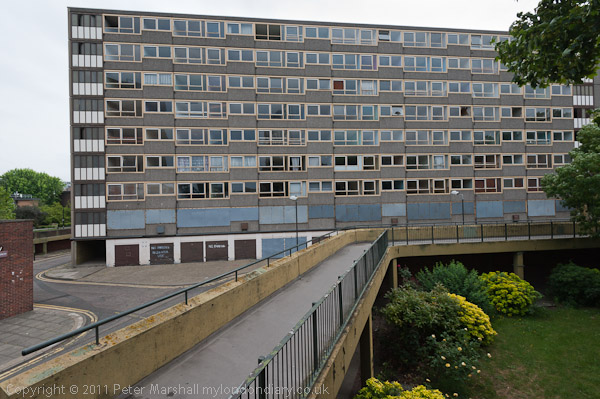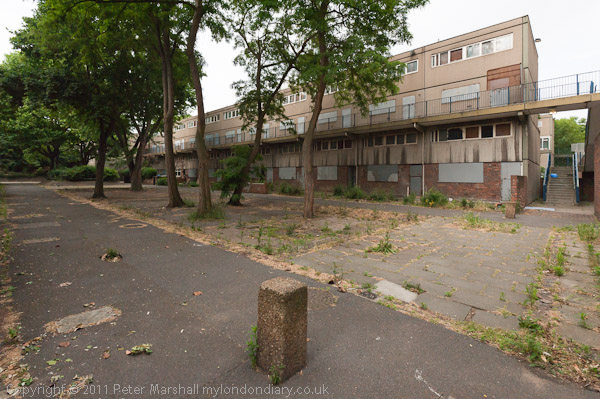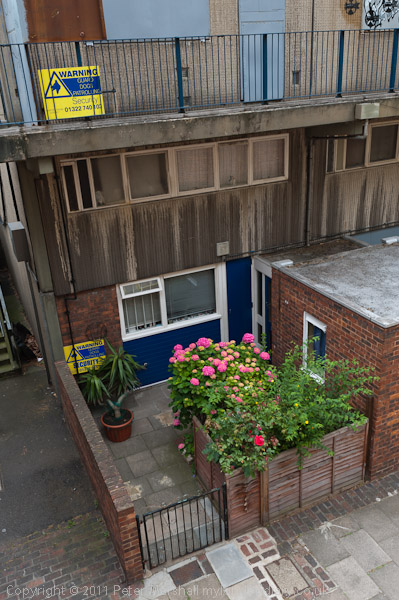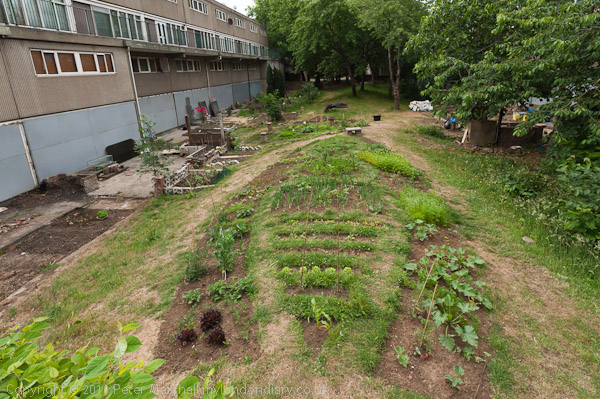
The Heygate estate, 2011
London’s Heygate Estate, 25 acres in a prime position next to the Elephant and Castle in Southwark has had a bad press. Completed in the early 1970s and home for years to more than a thousand families it was a brave and far-sighted attempt to provide high quality social housing in a remarkably green development for its time. Given proper management by the council over the years it would now be seen as perhaps the most successful development of its era. Instead it is a rotting, empty ghost city, waiting to be demolished and replaced by lower quality development which will doubtless make millions if not billions for private developers. The developers certainly got a bargain, paying only £20 million for a site and the advantage of some £1.5 billion of public funds going into the Elephant redevelopment scheme.

The Heygate estate, 2011
It had the disadvantage of being built at a time when architecture was passing through a visually brutal phase, and the vast slab blocks that surrounded it to create an oasis inside were on a massive scale. It didn’t look a friendly place from the outside, and in the early years before the many trees that were planted grew it was a little bleak inside.

The Heygate estate, 2011
Somewhere Southwark Council lost the plot – or perhaps changed to a very different one – and made a concerted and largely successful attempt to change what had been seen as a good place to live into a sink estate, through a lack of maintenance and using it to rehouse “problem families”; coupled with a great deal of bad press and TV documentaries – those walkways made for some great images and it was so handy to get to. The council describe the scheme as ‘failed architecture’ but in reality it was the council that failed it, and the architecture is still in excellent shape – and likely to have been longer-lasting than its proposed replacement.
You can read more of the story of how the Heygate was demonised in the Guardian article from March 2011, The death of a housing ideal and more about its present state at the blog set up by one of the few remaining residents, Adrian Glaspool – a good place to start is here. For more information see the Southwark Notes blog, which has a great deal of information and comment on the council’s actions here and elsewhere in the borough.

A few properties remain occupied on the Heygate estate, 2011
After the decision to demolish and sell off the estate was taken, the council started encouraging tenants to move out in 2007, giving them a six month time limit to find replacement homes (they had stopped giving secure tenancies in 2001, meaning that they had no obligation to rehouse the roughly 30% of tenants who had moved in since then.) Tenants were supposed to find properties through the council’s Homesearch scheme, but very few were on offer. Evictions and compulsory purchase, along with less legal measures, were eventually used to more or less clear the estate, with just a handful of residents now remaining. Labour councillors when in opposition accused the council of “strong-arming and intimidating tenants and leaseholders out of their homes on the Heygate” but little seemed to change after they were voted into power in 2010.
Leaseholders on the estate were treated in a particularly shabby fashion as the Council carried out a programme of what was essentially forcible removal from the estate. The leaseholder’s action group site states:
“Leaseholders were left to watch as their neighbours were moved out one-by-one, leaving them all alone in blocks infested with vermin. Vacated properties were not cleared before being sealed up, lifts were turned off, the district heating & hot-water system was turned off, estate lighting was turned off, cleaning services and rubbish collections reduced and postal services dropped.”
Also on their site you can find details of the ridiculous undervaluation of properties made by the council:
“Elderly leaseholders or those with language difficulties came off particularly bad, and the council was able to convince some to accept offers as low as £32,000 for a 1-bed flat and £66,500 for a 3-bed maisonette. “
Similar maisonettes in this area cost around £300-400 a week to rent, and the market price is probably in the range £175-250,000.
The blog quotes environmentalist Donnachadh McCarthy, writing in the ‘Southwark News‘ describing the demolition of the Heygate and Aylesbury estates as ‘one of the biggest carbon crimes of the decade by a local authority.’ It has certainly resulted in an enormous waste of public money, and as well as the carbon waste involved in demolition of usable buildings some 40 years before the end of their lifetime and their replacement by new build, the estate is now a considerable urban forest and most of its trees appear certain to be felled.
Like other buildings of its age the estate contains considerable amounts of asbestos, not a great safety hazard unless disturbed, but making the job of demolition of these structurally sound buildings difficult. For this reason it will be perhaps another four years before the demolition of the larger blocks actually starts although almost all the tenants and leaseholders have been forced out and the estate allowed to become derelict.

New garden on the Heygate estate, 2011
Recently a fringe area of the estate has been demolished, but work is not timetabled to start on the rest of the estate until late 2014 or early 2015. In April this year, some of the few remaining residents decided to clear the former garden areas and use the space to grow flowers and vegetables, informing the council who at first started legal proceedings for ‘unlawful gardening’ but then entered into talks aimed at authorising and controlling the allotments.
Residents and other interested parties held a day of workshops to try and influence the regeneration of the whole Elephant & Castle area on July 4 which I was unable to attend, but I took these pictures on the following day, along with many more on the Heygate estate, more of which will go on My London Diary shortly. In particular I made a number of panoramic views of the area which perhaps give a better impression of the estate and in particular its trees, and I’ll post some of these later.